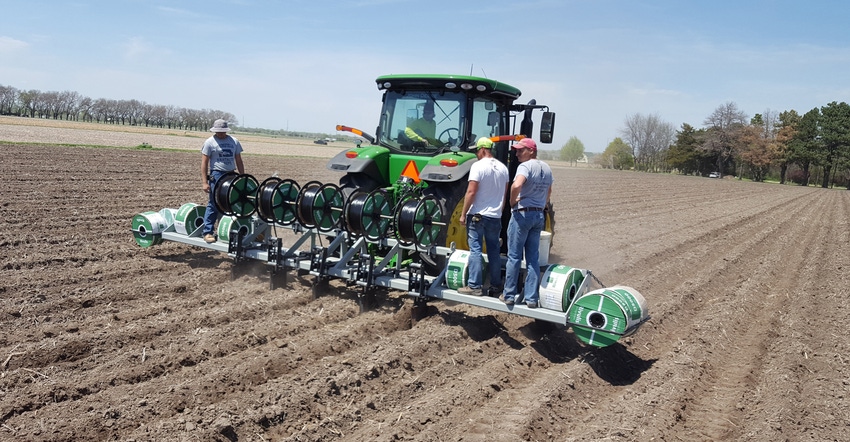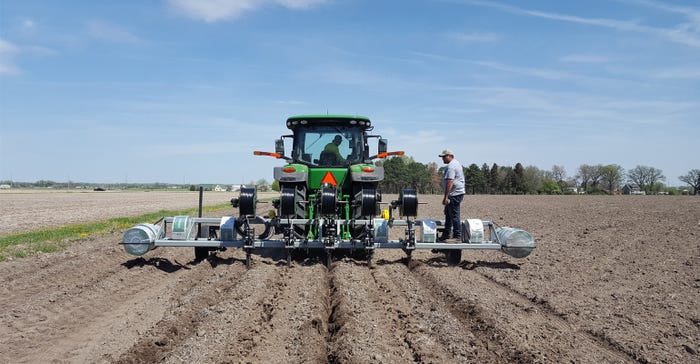
In Nebraska, subsurface drip irrigation may not have the foothold it does in states like California. However, SDI is gaining traction as a way to improve irrigation efficiency by delivering water straight to the crop's roots — although at a slower pace and with a higher initial cost.
Next year, the Testing Ag Performance Solutions farm management competition will offer participants a chance to irrigate their crops using SDI. This year, Daran Rudnick, Nebraska Extension agriculture water management specialist, and other researchers have installed an SDI system for the TAPS competition at the West Central Research and Extension Center near North Platte.
"It will be a little different from our sprinkler competition. There will be a lot more flexibility," Rudnick says. "Right now, we let participants in the sprinkler competition irrigate twice a week. With SDI, you would be able to irrigate more often, at smaller doses. We would likely kick it up to four times a week. Instead of three or four growth stages for fertigation, we might open it up to fertigating every week. Every week we'll tell you the growth stage and you have the opportunity to fertigate."
The SDI system, designed and installed by Eco-Drip, includes drip tape installed at 12 inches deep on 30-inch rows. Tape is often spaced 60 inches apart. However, in this system, each row will have its own tape, but crops will still be offset and planted on a different side of the tape each year.
 NARROW SPACING: In most SDI systems, tape is spaced at least 60 inches apart. However, in this system, tape will be spaced 30 inches apart. Each row of corn or soybeans will have its own tape, but crops will still be offset and planted on a different side of the tape each year. This ensures consistent irrigation throughout each of the 96 plots in the 10-acre field.
NARROW SPACING: In most SDI systems, tape is spaced at least 60 inches apart. However, in this system, tape will be spaced 30 inches apart. Each row of corn or soybeans will have its own tape, but crops will still be offset and planted on a different side of the tape each year. This ensures consistent irrigation throughout each of the 96 plots in the 10-acre field.

This way, sensors can still be installed in the crop row without worrying about puncturing the drip tape — and no one has to worry about planting soybeans on top of old corn rows. The drip tape itself was donated by Rivulis, while Eco-Drip provided valves, flowmeters and other components of the system.
Each plot under the SDI system will have 12 rows, each 165 feet long, with 96 zones total on the field, which is roughly 11 acres in size. With 24 treatments replicated four times, there's a much bigger data set to manage compared to a typical drip system, which might have anywhere from five to eight zones.
"Each zone has its own flowmeter and valve. We have unbelievable amounts of equipment, piping and flush valves, you name it," Rudnick says. "We have to be more thoughtful in managing and collecting data from all of these zones, getting the right number of replications and treatments, and making sure we don't overlook something."
However, there is an obvious benefit. This way, researchers can observe two irrigated crops simultaneously — one under center-pivot irrigation, and the other with SDI. It also offers more flexibility for the TAPS competition.
"Whether you're under the pivot or the SDI system, everyone's plots are in a random location, and you have one sensor for all of your plots," Rudnick explains. "Under the pivot, if the sensor is on the western edge of the field, and the pivot's coming from the eastern side, your sensor might be the last to get the water — and it might influence your decision."
With SDI, it may take about 17 hours to water an acre-inch, but it still irrigates all plots simultaneously.
"Timing is going to be consistent; it'll open up flexibility for the grower. They can respond more instantly based on sensor data. Participants are going to be able to see quickly how their crops or soils are responding to their decisions and don't have to worry about a lag effect," Rudnick says. "It also opens up opportunities for new sensors. Now we can incorporate canopy-based instrumentation because we don't have to worry about those sensors getting hit by the pivot when it passes over."
About the Author(s)
You May Also Like






